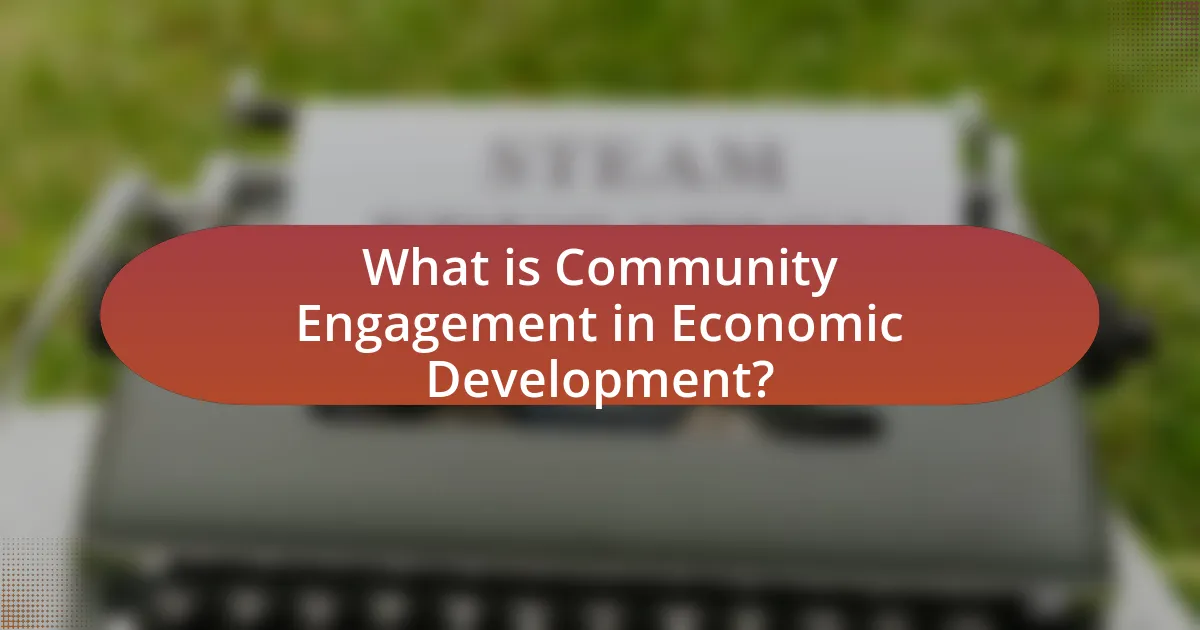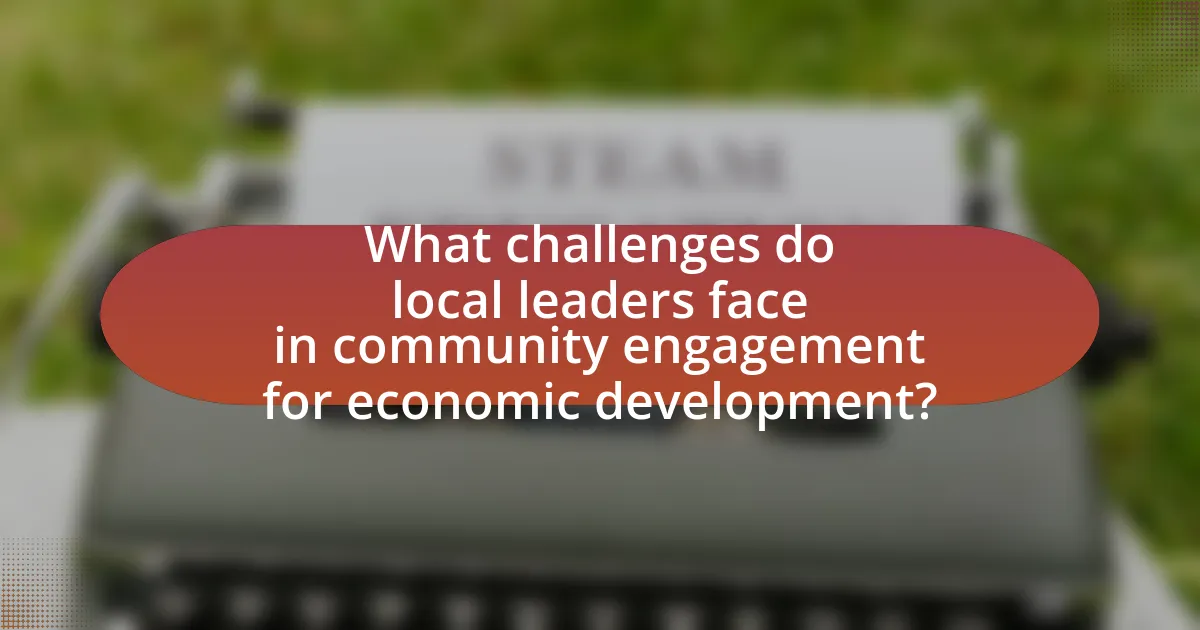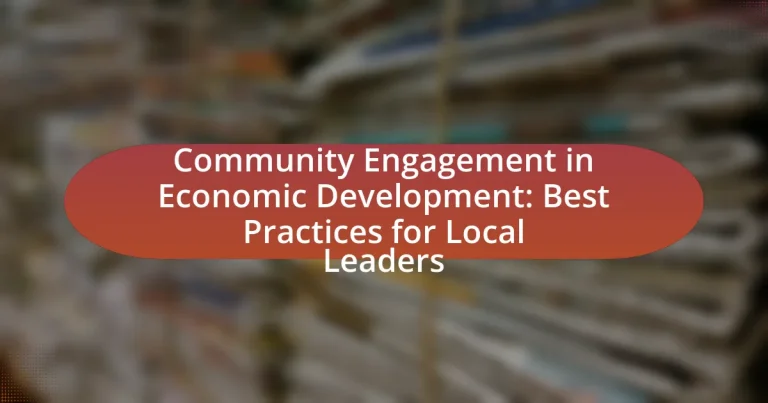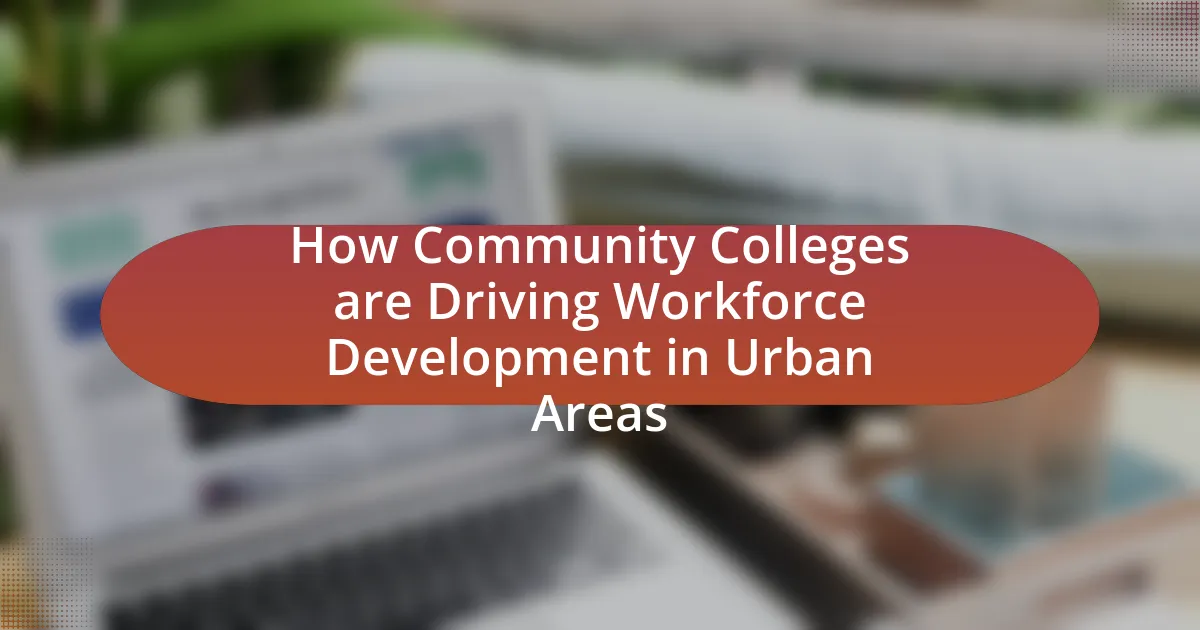Community engagement in economic development involves the active participation of residents in shaping economic initiatives that impact their lives. This article explores the significance of community engagement, highlighting its influence on sustainable economic growth and effective decision-making. Key elements of successful engagement include clear communication, active participation, and mutual respect among stakeholders. The article also examines regional variations in engagement practices, the essential role of local leaders, and best practices for fostering inclusive participation. Additionally, it addresses challenges faced by leaders and offers practical strategies to enhance community involvement in economic development planning.

What is Community Engagement in Economic Development?
Community engagement in economic development refers to the active participation of community members in the planning and implementation of economic initiatives that affect their lives. This engagement fosters collaboration between local governments, businesses, and residents, ensuring that development strategies reflect the community’s needs and priorities. Research indicates that communities with higher levels of engagement experience more sustainable economic growth, as evidenced by a study from the International Economic Development Council, which found that inclusive decision-making leads to better outcomes in job creation and local investment.
How does community engagement influence economic development?
Community engagement significantly influences economic development by fostering collaboration between local stakeholders, which leads to more effective decision-making and resource allocation. Engaged communities are more likely to identify their unique needs and priorities, resulting in tailored economic strategies that enhance local growth. For instance, a study by the International Economic Development Council found that communities with high levels of engagement saw a 20% increase in local business retention rates compared to less engaged areas. This demonstrates that active participation not only strengthens community ties but also drives sustainable economic outcomes.
What are the key elements of effective community engagement?
The key elements of effective community engagement include clear communication, active participation, mutual respect, and sustained relationships. Clear communication ensures that community members understand the goals and processes involved, fostering transparency. Active participation encourages individuals to contribute their ideas and feedback, which enhances ownership and commitment to initiatives. Mutual respect builds trust among stakeholders, recognizing diverse perspectives and valuing each participant’s input. Sustained relationships involve ongoing dialogue and collaboration, which are essential for adapting to community needs and maintaining engagement over time. These elements are supported by research indicating that communities with strong engagement practices see improved outcomes in economic development and social cohesion.
How does community engagement differ across various regions?
Community engagement varies significantly across regions due to cultural, economic, and social factors. In urban areas, engagement often focuses on organized community groups and local government initiatives, while rural regions may rely more on informal networks and personal relationships. For instance, a study by the National Civic League highlights that urban communities tend to have structured engagement processes, such as public forums and advisory boards, whereas rural communities often engage through local events and gatherings, reflecting their close-knit nature. Additionally, socioeconomic status influences engagement levels; wealthier regions may have more resources for community programs, while economically disadvantaged areas may face barriers to participation, as noted in research by the Urban Institute.
Why is community engagement essential for local leaders?
Community engagement is essential for local leaders because it fosters trust, enhances decision-making, and promotes sustainable development. Engaging with the community allows leaders to understand the needs and priorities of residents, which leads to more informed policies and initiatives. Research indicates that communities with active engagement experience higher levels of civic participation and satisfaction, as evidenced by a study from the International City/County Management Association, which found that 70% of local governments reported improved service delivery through community involvement. This direct connection between leaders and constituents ultimately strengthens the social fabric and economic resilience of the community.
What role do local leaders play in fostering community engagement?
Local leaders play a crucial role in fostering community engagement by acting as facilitators and advocates for collaboration among residents. They create platforms for dialogue, ensuring that community members have a voice in decision-making processes. For instance, local leaders often organize town hall meetings and workshops, which have been shown to increase participation rates in community initiatives by up to 40%, according to a study by the International City/County Management Association. Additionally, they leverage local resources and networks to connect residents with opportunities for involvement, thereby enhancing civic participation and strengthening community ties.
How can community engagement enhance local economic initiatives?
Community engagement enhances local economic initiatives by fostering collaboration between residents, businesses, and local governments, leading to more effective and sustainable economic development strategies. Engaged communities are more likely to identify their unique needs and resources, which can inform targeted initiatives that drive local growth. For instance, a study by the International Economic Development Council found that communities with high levels of public participation in economic planning saw a 20% increase in local business retention rates compared to those with minimal engagement. This demonstrates that when community members actively participate, they contribute valuable insights that can shape policies and programs, ultimately resulting in stronger local economies.

What are the best practices for community engagement in economic development?
The best practices for community engagement in economic development include fostering inclusive participation, utilizing transparent communication, and building partnerships with local stakeholders. Inclusive participation ensures that diverse community voices are heard, which can be achieved through public forums, surveys, and focus groups. Transparent communication involves sharing information about economic initiatives and decisions openly, which builds trust and encourages community involvement. Building partnerships with local stakeholders, such as businesses, non-profits, and educational institutions, enhances resource sharing and collaborative efforts, leading to more effective economic strategies. Research shows that communities with strong engagement practices experience higher levels of economic resilience and growth, as evidenced by studies conducted by the International Economic Development Council.
How can local leaders effectively communicate with their communities?
Local leaders can effectively communicate with their communities by utilizing multiple channels such as town hall meetings, social media platforms, and newsletters. These methods allow leaders to disseminate information, gather feedback, and foster dialogue. For instance, a study by the International City/County Management Association found that communities with regular town hall meetings reported higher levels of citizen engagement and satisfaction. Additionally, leveraging social media enables leaders to reach a broader audience quickly, as evidenced by a Pew Research Center report indicating that 69% of adults use social media, making it a vital tool for communication. By combining these approaches, local leaders can enhance transparency, build trust, and ensure that community members feel heard and involved in decision-making processes.
What communication strategies are most effective for engaging diverse populations?
Effective communication strategies for engaging diverse populations include culturally relevant messaging, active listening, and the use of multiple communication channels. Culturally relevant messaging ensures that the content resonates with the values and experiences of different groups, enhancing relatability and understanding. Active listening fosters trust and encourages participation by acknowledging the unique perspectives of diverse individuals. Utilizing multiple communication channels, such as social media, community meetings, and printed materials in various languages, increases accessibility and ensures that information reaches a broader audience. Research indicates that these strategies lead to higher engagement rates and more effective community participation in economic development initiatives.
How can technology facilitate better communication in community engagement?
Technology can facilitate better communication in community engagement by providing platforms for real-time interaction and information sharing. Tools such as social media, mobile applications, and online forums enable community members to connect, share ideas, and collaborate effectively. For instance, a study by the Pew Research Center found that 69% of adults in the U.S. use social media, which can be leveraged to disseminate information quickly and gather feedback from the community. Additionally, technology allows for the use of data analytics to understand community needs and preferences, enhancing the relevance of engagement efforts.
What methods can be used to involve community members in economic development planning?
To involve community members in economic development planning, methods such as public forums, surveys, focus groups, and participatory budgeting can be utilized. Public forums allow community members to voice their opinions and ideas directly to planners, fostering transparency and collaboration. Surveys can gather quantitative data on community needs and preferences, ensuring that planning reflects the population’s priorities. Focus groups facilitate in-depth discussions among diverse community members, providing qualitative insights into local issues. Participatory budgeting empowers residents to directly influence how public funds are allocated, enhancing their investment in the development process. These methods have been shown to increase community buy-in and improve the relevance of economic development initiatives, as evidenced by case studies in cities like Portland, Oregon, where community engagement led to more effective urban planning outcomes.
What are the benefits of participatory planning processes?
Participatory planning processes enhance community engagement and improve decision-making by involving stakeholders in the planning stages. These processes lead to more inclusive outcomes, as they allow diverse perspectives to be considered, which can result in solutions that better reflect the community’s needs. Research indicates that projects utilizing participatory planning often experience higher levels of public support and trust, as stakeholders feel their voices are heard and valued. For instance, a study by the American Planning Association found that communities engaged in participatory planning reported increased satisfaction with local governance and improved social cohesion.
How can surveys and feedback mechanisms improve community involvement?
Surveys and feedback mechanisms enhance community involvement by providing a structured way for residents to express their opinions and needs, thereby fostering a sense of ownership and participation in local initiatives. When communities are surveyed, they can identify priorities and concerns, which local leaders can then address, leading to more relevant and effective economic development strategies. Research indicates that communities engaged through feedback mechanisms experience higher levels of trust and collaboration, as evidenced by a study from the International Association for Public Participation, which found that 70% of participants felt more connected to their community when their voices were heard in decision-making processes. This active engagement not only improves satisfaction with local governance but also encourages ongoing participation in future initiatives.

What challenges do local leaders face in community engagement for economic development?
Local leaders face several challenges in community engagement for economic development, including lack of trust, limited resources, and diverse stakeholder interests. Lack of trust can hinder effective communication and collaboration, as community members may be skeptical of leaders’ intentions or capabilities. Limited resources, such as funding and personnel, restrict leaders’ ability to implement engagement initiatives effectively. Additionally, diverse stakeholder interests create complexity, as leaders must navigate varying priorities and expectations among different community groups. These challenges can impede the overall effectiveness of economic development efforts, as evidenced by studies showing that successful community engagement often correlates with higher levels of trust and resource allocation.
How can local leaders overcome resistance to community engagement?
Local leaders can overcome resistance to community engagement by actively involving community members in the decision-making process. This approach fosters trust and ownership among residents, making them more likely to participate. Research indicates that when local leaders implement participatory methods, such as community forums and surveys, they can significantly increase engagement levels. For instance, a study by the International Association for Public Participation found that communities with high levels of involvement in planning processes reported a 30% increase in satisfaction with local governance. By prioritizing transparency and communication, local leaders can effectively address concerns and build a collaborative environment that encourages community participation.
What strategies can be employed to build trust within the community?
To build trust within the community, local leaders can employ strategies such as transparent communication, active listening, and consistent engagement. Transparent communication involves sharing information openly about decisions, processes, and outcomes, which fosters a sense of inclusion and accountability. Active listening ensures that community members feel heard and valued, allowing leaders to address concerns and adapt initiatives accordingly. Consistent engagement through regular meetings, feedback sessions, and community events strengthens relationships and demonstrates commitment to the community’s needs. Research indicates that communities with high levels of trust experience better collaboration and participation in local initiatives, leading to more effective economic development outcomes.
How can leaders address the concerns of marginalized groups in economic development?
Leaders can address the concerns of marginalized groups in economic development by actively engaging these communities in the decision-making process. This involvement ensures that their unique needs and perspectives are considered, leading to more equitable economic policies. For instance, research from the Urban Institute highlights that inclusive stakeholder engagement can improve project outcomes and foster trust between marginalized communities and local governments. By implementing regular consultations, providing platforms for feedback, and ensuring representation in planning committees, leaders can create a more inclusive economic development framework that directly addresses the concerns of marginalized groups.
What are the common pitfalls in community engagement efforts?
Common pitfalls in community engagement efforts include lack of clear objectives, insufficient outreach, and failure to involve diverse community voices. Without clear objectives, initiatives can become unfocused, leading to ineffective engagement. Insufficient outreach often results in low participation rates, as potential stakeholders may not be aware of opportunities to engage. Additionally, failing to include diverse voices can lead to decisions that do not reflect the community’s needs, ultimately undermining trust and collaboration. Research indicates that inclusive engagement strategies significantly enhance community buy-in and project success, highlighting the importance of addressing these pitfalls.
How can local leaders avoid tokenism in community engagement?
Local leaders can avoid tokenism in community engagement by actively involving diverse community members in decision-making processes. This means creating platforms for genuine dialogue where all voices are heard and valued, rather than merely including individuals for appearances. Research indicates that inclusive practices lead to better outcomes; for instance, a study by the National League of Cities found that cities with robust community engagement strategies saw a 30% increase in public trust. By prioritizing authentic participation and ensuring that community input shapes policies, local leaders can foster meaningful engagement and mitigate the risk of tokenism.
What are the consequences of inadequate community engagement?
Inadequate community engagement leads to a lack of trust and support from the community, resulting in ineffective economic development initiatives. When local leaders fail to involve community members in decision-making processes, projects often do not reflect the needs or priorities of the population, leading to low participation rates and potential project failure. Research indicates that communities with high levels of engagement experience better economic outcomes, as seen in the 2018 study by the International Economic Development Council, which found that inclusive practices enhance project sustainability and community satisfaction.
What practical tips can local leaders implement for successful community engagement?
Local leaders can implement several practical tips for successful community engagement, including fostering open communication, building trust, and involving diverse community members in decision-making processes. Open communication can be achieved through regular town hall meetings and online platforms, allowing residents to voice their concerns and suggestions. Building trust involves transparency in actions and decisions, which can be supported by sharing data and progress reports on community projects. Involving diverse community members ensures that various perspectives are considered, enhancing the relevance and effectiveness of initiatives. Research shows that communities with high levels of engagement experience better economic outcomes, as evidenced by a study from the International Economic Development Council, which found that inclusive engagement strategies lead to more sustainable development.
How can local leaders create a sustainable engagement framework?
Local leaders can create a sustainable engagement framework by establishing clear communication channels, fostering community partnerships, and implementing feedback mechanisms. Clear communication ensures that community members are informed and involved in decision-making processes, which builds trust and transparency. Fostering partnerships with local organizations and stakeholders enhances resource sharing and collaborative efforts, leading to more effective engagement. Implementing feedback mechanisms, such as surveys or community forums, allows leaders to gather input and adapt strategies based on community needs, ensuring ongoing relevance and sustainability. These practices are supported by studies showing that effective community engagement leads to improved economic outcomes and stronger community ties.
What resources are available for local leaders to enhance community engagement?
Local leaders can enhance community engagement through various resources, including training programs, toolkits, and online platforms. Training programs, such as those offered by the International City/County Management Association (ICMA), provide leaders with skills in communication and collaboration. Toolkits, like the Community Engagement Toolkit from the National Coalition for Dialogue & Deliberation, offer practical strategies for involving residents in decision-making processes. Additionally, online platforms such as Nextdoor and Facebook Groups facilitate direct communication between leaders and community members, fostering a sense of connection and involvement. These resources are designed to empower local leaders to effectively engage their communities, ultimately leading to more inclusive and responsive governance.




